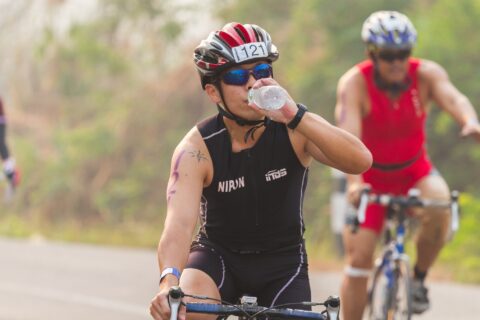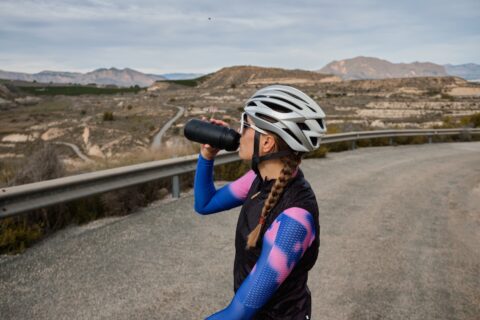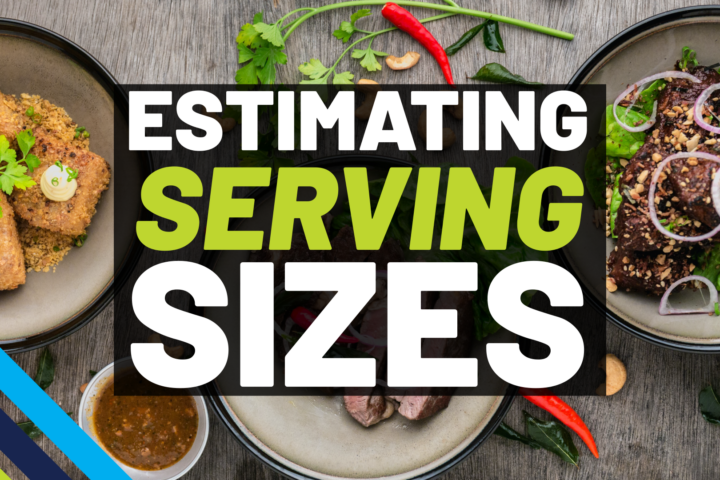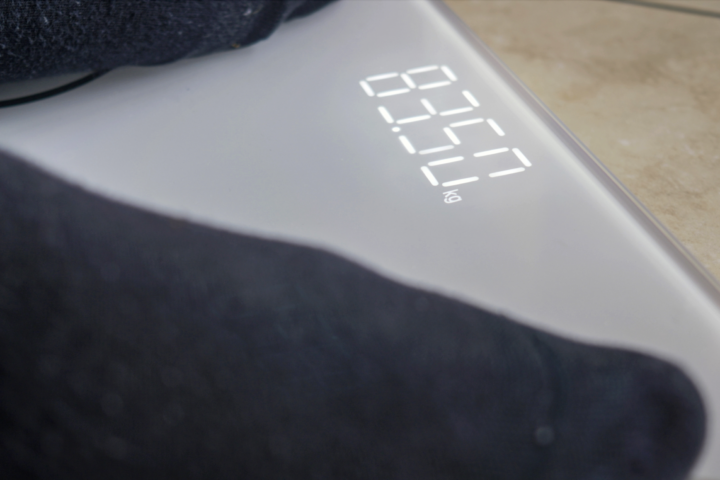Coach and sports nutritionist Ryan Kohler shares his sports nutrition guide for endurance mountain bike races.
Video Transcript
Hey Lake City Alpine 50 racers! I’m Ryan Kohler, head coach and physiologist at Fast Talk Labs, and I’m excited to be here with you today to talk about your race day sports nutrition.
The Three Major Nutrients You Need to Perform at Your Best
I’ll be covering the three major nutrients that you need to perform at your best, along with a primer on nutrition periodization. This is going to help you figure out when to consume your fuel, and also work on how much you should be consuming. With these three nutrients, there’s no real magic in it. These are just fundamental pieces of the puzzle that we need to figure out. The three nutritents are sugar, water, and sodium. If you can get these worked out, you’ll be 95% of the way there.
Sugar
Let’s start with the first nutrient: sugar. When I mention sugar from now on, I’ll be also talking about it as carbohydrate. So we’re going to start with this study that was done in 2014 by Stellingwerff & Cox. It was a systematic review that looked at 61 different papers on carbohydrate, and three different conditions where carbohydrate was either increasing performance, decreasing performance, or there was no change.
Now, when we look at this graph (see video above at 01:05), we see that 82% of those studies showed an improvement in performance, 18% showed no change, and none showed a decrease in performance—therefore, we know carbohydrates are good, but the question is how much should we consume? In these studies, you’ll see that for events over two and a half hours (which we know Lake City will take us over two and a half hours) we should be consuming about 60 to 80 grams of carbohydrate per hour, especially when we have high intensity.
Then, in another study that was done here in Colorado, we took a look at the Leadville Mountain Bike 100 race, and we looked at finishers who went under nine hours, and compared them to finishers who went over nine hours. What we found was that the faster finishers consumed, on average, about 13 grams of carbohydrate per hour more than the slower finishers. So, what’s the take-home message here? Well, as you’re building your fitness and getting ready for the race, you want to make sure that you’re adapting your nutrition habits (particularly carbohydrate intake) to meet those continued metabolic demands. If you’re already one of the faster racers, make sure you consume more and train yourself to get to that point.
Sodium
The second nutrient we’ll talk about here is sodium.
Let’s start with the importance of sodium. What does it do?
- Increases our thirst and our desire to drink
- Decreases our urine production
- Stimulates water retention
Ultimately, sodium helps us hold on to that fluid in the body which helps us to maintain our sweating, offload the heat, and reduce our fatigue so we can perform at our best.
Now we need to figure out how much sodium we should actually consume. Well, you’ll see that there are multiple ranges and the range for sodium intake is quite wide. One reference will show you 20 to 50 milli equivalents per liter, or about 460 to a little over 1000 milligrams per liter of fluid. Other references you’ll see may show 10 to 30 milli equivalents per liter, which is about 230, up to almost 700 milligrams per liter, so you can see the ranges are quite wide. What does this mean for you? Start somewhere in the middle, you can flex up or down as necessary. But, to dial things in a little bit more, do a pre- and post-exercise weigh-in in conditions that are similar to where you’ll be racing, and adjust your sodium intake so that you can drink to maintain no more than a 2% loss in body weight.
Water
The third and final nutrient is water. Water plays an important role across the board because water works with the carbohydrate intake and with the sodium intake to help maintain and improve our performance. Recommendations for water intake vary pretty widely as well, but I typically see a lot of athletes somewhere in that range of 20 to 27 fluid ounces per hour. That generally seems like an okay place to start. Again, you’ll need to flex this up or down based on your needs. However, when we talk about different environments, such as high alpine environments or very hot environments where we’re blowing off a lot more fluid and sweating we may need to flex these intake values up a bit closer to a liter. I’ve seen athletes consuming about 30 to 36 fluid ounces in some of these cases.
Timing It Right: Nutrition Periodization
Now that we have an understanding of the top nutrients we need to bring with us, let’s move on to nutrition periodization so we can strategize on where on the course we’ll actually consume everything. As a coach, these are some tips I like to give my athletes to figure out their individual nutrition periodization strategies.
Tips for Dialing in Your Nutrition Strategy
Get out on the course and scout it out
This will help you see the terrain, feel it, and really get the best idea of the environment.
Check the elevation profile of the course
This will give you valuable insights into where you’re going to be climbing and descending. If you can’t get out on the course to pre-ride it, check it out on YouTube. There are tons of videos you can look up to find certain roads or passes and get a really good feel for what it’s like.
Ask yourself questions like, “Can I eat and drink while I’m climbing or is it too steep?” or “Can I descend this and still eat and drink or do I need to adjust my plan here?”
Once you have a good sense of the elevation profile and what the demands are like throughout the course then what I would do is make little notes and say, “This is really steep, I can’t eat and drink here, so I need to do it before.” This allows you to then plan out your strategy, according to the profile.
Overview of Kohler’s Race Plan
I’m excited to be joining you on the course for the Lake City Alpine 50. Here’s an overview of my plan.
You’ll see my elevation profile shown here (see video above at 05:23) with the notes on it to help inform where I can take on different fuels or fluids throughout the event.
The next question is actually: How long will this take? This will inform how much fuel I need to have with me.
Cinnamon Pass Breakdown
Cinnamon Pass is our first climb, it’s a long one at 21 miles. From looking at previous data, I know that at these elevations, my average climbing speed is somewhere between about seven to nine miles per hour, depending on the grade and the type of terrain, how rocky it is, etc. With this in mind, I know that worst-case scenario, I can plan for about three hours to be out there. Best case scenario is about two to two hours and 15 minutes.
Engineer Pass Breakdown
Next, we come up to Engineer Pass, which is the next big climb of the day. This is a little bit shorter, but very, very steep, as you can see on the elevation profile. This is about three miles long, a touch under, so I’m planning for about 30 minutes or so to complete this. I know there’s going to be some hike-a-bike here, so I’m planning to have fuel that I can also consume while walking the bike.
Henson Creek Road Breakdown
Finally, after we crest Engineer Pass, and we start coming down for the return trip home, we go down Henson Creek Road, that’s about 14 miles long. As you can see in the elevation profile, it’s a net downhill with some little bumps along the way. I’m assuming this is going to take about 45 to 60 minutes, hopefully there will be some other riders to be on, I can sit on wheels, eat and drink and just keep the energy up toward the end.
Hourly Consumption Breakdown
Taking the entire course into consideration, my estimated time to be out there is between about four hours and 20 minutes to about four hours and 50 minutes. Knowing this is going to help me now break down and work out how much I need to consume on an hourly basis.
Next, I base my intake goals off of my output, and I strive for 40 to 50% of my total expenditure. For this race, that means I’ll be consuming a total of about 1,170- 1,463 calories.
Let’s break that down hourly by the expected time, and we’re at roughly 300 calories per hour (see video above at 07:22).
Fluid Intake
In terms of fluid intake and fuel that’s in the bottle, I’m aiming for about 21 fluid ounces per hour, and you can see at the very end, we’re going to taper it down because it’s a shorter segment, so about a cup or so of fluid to finish off that last bit.
Solid Food Intake
Solid food, I’m taking in about one to two gels per hour to hit my carbohydrate targets. I’m going to use that one aid station to take out as much as I possibly can, because I know that’s going to happen right before a descent so I’ll pack the food in, let it digest on the way down, and then, of course, toward the end as I start to get potentially tired of some of the sugary things, I’ll take in some more solid food and just try to keep the stomach happy to finish.
I’m so excited to join you on the course at the Lake City Alpine 50. Be sure to reach out to Fast Talk Labs for more information on race day sports nutrition!
References
Jeukendrup, A. (2014). A step towards personalized sports nutrition: Carbohydrate intake during exercise. Sports Medicine, 44(S1), 25–33. https://doi.org/10.1007/s40279-014-0148-z
Karelis, A. D., Smith, J. E. W., Passe, D. H., & Péronnet, F. (2010). Carbohydrate administration and exercise performance. Sports Medicine, 40(9), 747–763. https://doi.org/10.2165/11533080-000000000-00000
Kohler, R., & San-Millan, I. (2020, July 12). Carbohydrate intake during endurance mountain bike racing. Academia.edu. Retrieved August 10, 2022, from https://www.academia.edu/83030664/Carbohydrate_Intake_during_Endurance_Mountain_Bike_Racing
Smith, J. E. W., Zachwieja, J. J., Horswill, C. A., Pascoe, D. D., Passe, D., Ruby, B. C., & Stewart, L. K. (2010). Evidence of a carbohydrate dose and prolonged exercise performance relationship. Medicine & Science in Sports & Exercise, 42(5), 84. https://doi.org/10.1249/01.mss.0000385615.40977.c3
Stellingwerff, T., & Cox, G. R. (2014). Systematic review: Carbohydrate supplementation on exercise performance or capacity of varying durations. Applied Physiology, Nutrition, and Metabolism, 39(9), 998–1011. https://doi.org/10.1139/apnm-2014-0027



